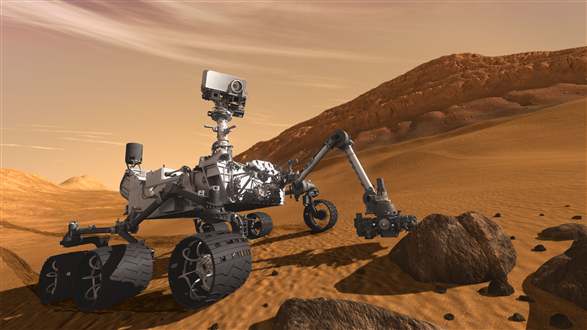NASA's Curiosity Mars rover has successfully landed on the surface of Mars.
Curiosity landed on Mars at 06:32 BST and will now embark on a two-year mission to establish whether or not Mars may once have supported life.
Okay, so it's not strictly a car, but Curiosity may well be the most important vehicle ever created, so we've taken it on an (imaginary, obviously) road test.
Curiosity Road Test
Don't let the name fool you, the Curiosity Mars rover is not actually a Rover. And this is a good thing too, as it needs to be able to withstand the 354-million-mile journey to Mars, not to mention the controlled landing once it gets there. If Curiosity had have been built by Rover, it would have broken down just outside the factory or, even more likely, not been built at all due to industrial action.
Power
Curiosity is powered by a radioisotope thermoelectric generator (RTG) which produces energy from the natural decay of plutonium-238. This means that Curiosity is a nuclear-powered vehicle. Unfortunately, the Mars rover manages a top speed of just 90-metres per hour, making it significantly slower than any car on the market today (apart from the Perodua Myvi).
Handling
Curiosity is fitted with six wheels which make it excellent at traversing rough terrain. In fact, it can climb obstacles of roughly 30-inches in height. It weighs just under a tonne and is roughly the same size as a MINI Hatch. Whether or not the Mars rover is as entertaining to drive as the little MINI remains to be seen.
Technology
Unfortunately, the Mars rover has to do without a CD player, MP3 connectivity and Bluetooth, and is instead equipped with 256KB of EEPROM and DRAM (whatever these are) and 2GB of flash memory. All of Curiosity's electronics are radiation-hardened to prevent them from frying when exposed to the huge amounts of radiation present in outer space.
Brakes
Curiosity's stopping power is impressive, which is reassuring as it entered the Martian atmosphere at just over 8,000mph. The rover was slowed firstly by friction from the atmosphere and then by a supersonic parachute. Closer to the ground, rockets were fired downwards to slow Curiosity to landing speed.
Price
If you're in the market for a Mars rover, you'll have to be pretty well-heeled as Curiosity costs the not inconsiderable sum of $1.6 billion dollars. This makes it slightly cheaper than a Chevrolet Volt or a Toyota Prius+ but, remember, Curiosity won't give you that smug sense of self-satisfaction that the others will.
Verdict
Although it won't work as a family car, we think Curiosity is a fantastic machine and we can't wait to see whether it finds evidence of life on Mars.








